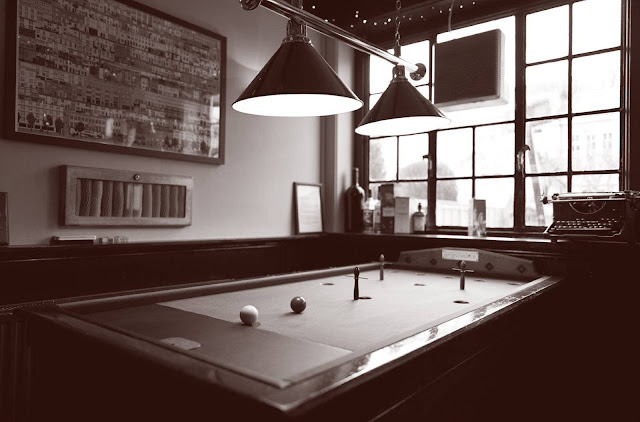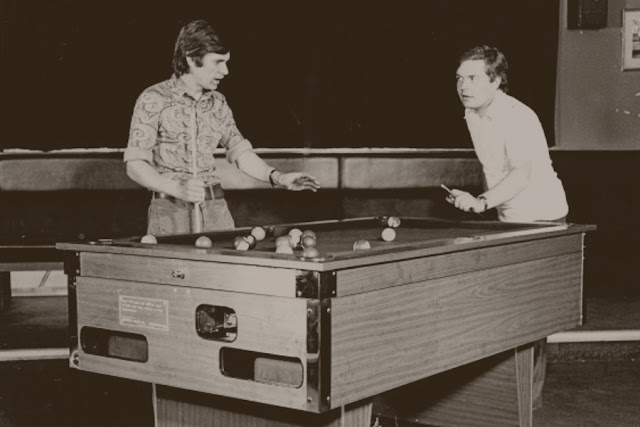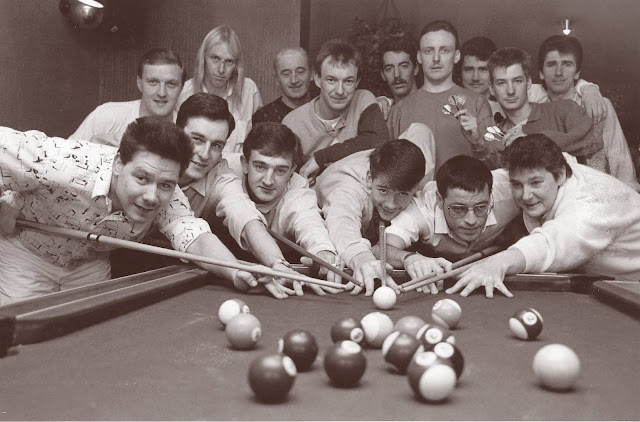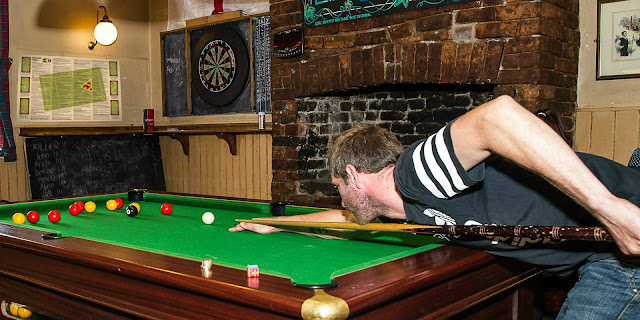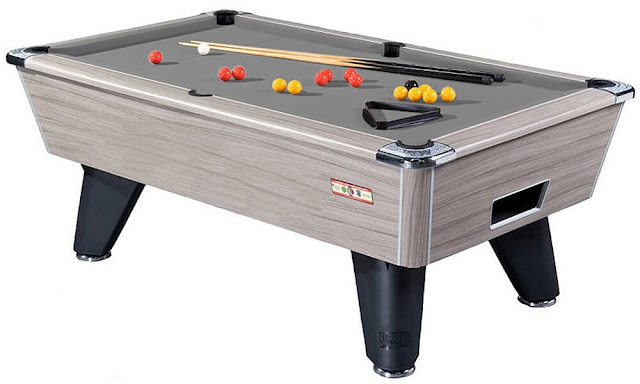Blackball Pool Rules !
Blackball pool as played in the United Kingdom, and indeed throughout the world, has its origins in the game of 8ball popularised in the USA early in the last century.
Overview
Post-war Britain saw more pubs built throughout the nation than at any other time in history and for many landlords competitive indoor games played a vital role in attracting customers and generating income.
A host of pub games were played.
Seated at a table, the locals might enjoy games such as euchre, whist, cribbage and dominoes.
Standing room, plus just a little more energy, was required for those who fancied shove ha’penny, table skittles, darts and bar billiards.
In fact bar billiards, which is still played today, was first introduced to pubs in the United Kingdom in the 1930s, but other cue sports were largely considered impractical for public bars due to limited space.
For many years snooker, and to a lesser extent English billiards, had been played in social clubs and billiard halls, but pool on a smaller table was eventually to become the most widely enjoyed cue sport throughout Britain.
It was around 1970 that the first pool tables began to appear in the UK's pubs.
It was around 1970 that the first pool tables began to appear in the UK's pubs.
In those days there was experimentation with the table specifications and a range of coin-operated tables became available.
Some designs were more successful and aesthetically pleasing than others, but as time passed a degree of standardisation was achieved.
By the late 1970's the game had become well established throughout the United Kingdom.
Other countries in which it gained rapid acceptance were Ireland, France, South Africa and Australia.
Reflecting its American origin, when first introduced pool was played with solid-coloured balls numbered 1 to 7 and striped balls numbered 9 to 15, of the kind shown here.
Such ball sets were referred to as 'spots and stripes' in the UK and they continue to be used in the games of American pool and Chinese eightball.
Other countries in which it gained rapid acceptance were Ireland, France, South Africa and Australia.
Reflecting its American origin, when first introduced pool was played with solid-coloured balls numbered 1 to 7 and striped balls numbered 9 to 15, of the kind shown here.
Such ball sets were referred to as 'spots and stripes' in the UK and they continue to be used in the games of American pool and Chinese eightball.
Blackball Equipment
If a pub landlord intends to encourage pool players there must be ample room around the table, adequate lighting, a level playing surface which is regularly recovered, a selection of functional cues and of course pool balls which aren't showing signs of serious wear and tear.
Added to that a rules poster and chalk board wouldn't go amiss.
It may be however that pubs and clubs are the venues for league competitions or other pool events, in which case there's likely to be a demand for equipment of a higher standard.
Added to that a rules poster and chalk board wouldn't go amiss.
It may be however that pubs and clubs are the venues for league competitions or other pool events, in which case there's likely to be a demand for equipment of a higher standard.
CUES
The cues preferred by blackball players more closely resemble in dimensions and weight those favoured by snooker players than for example American pool. They tend however to be a little lighter and have a narrower tip than most snooker cues.
Tips are generally from 8 to 9mm in diameter with a cue length of 57 inches or less.
The majority of both blackball and snooker cues are made from ash or maple.
Maple, unlike ash, has no grain and is the harder wood.
Many players use a 2-piece cue which is of course more convenient to carry and store.
Enthusiastic players may own a cue specifically for breaking up the cluster of racked balls at the start of a frame of pool. A light weight break cue is considered most effective.
BALLS
Red and yellow ball sets (alternatively known as casino balls) are now favoured.
The transition from numbered balls came about in part because the numbers serve no function in blackball. It's also the case that two contrasting colour sets are also easier to distinguish by spectators on video and television.
Occasionally blue balls will replace the red, for example when the game is played in South Africa.
Up until recently the rules have not specified colours.
The coloured object balls and the black ball are 2 inches in diameter.
The cue ball is smaller. The white is 1/8th of an inch less in width to enable it alone to return to a player through the mechanism of coin-operated machines should it accidentally be potted during a frame of blackball pool.
It is the small size of the cue ball which has influenced the configuration of cues used to play blackball.
For consistency, the smaller cue ball is still used when the game is played on tables without a coin mechanism, a so-called ‘free-play’ table.
Above the object ball sizes are compared for the games of Russian pyramid, Carom billiards, American pool, Snooker and English (blackball) pool.
TABLES
As has been mentioned, it was in the 1970s that a degree of standardisation in the dimensions and playing characteristics of tables became established.
Most significantly, in 1973, the first of the legendary 'Superleague' tables appeared on the market.
It was 7 feet in length, had a slate bed and the same ball to pocket ratio as a snooker table.
The table was first made by a company called Hazel Grove Music and then later by Riley Snooker.
By the 1990s over 120,000 such tables had been manufactured and distributed throughout the UK and Europe.
The snooker player Alex Higgins endorsed the Superleague table and appeared at exhibitions demonstrating its attributes.
The standard table dimension remains 7ft X 4ft which gives a playing surface of 6ft X 3ft.
In the photo is an ever popular 'Supreme' model.
It was 7 feet in length, had a slate bed and the same ball to pocket ratio as a snooker table.
The table was first made by a company called Hazel Grove Music and then later by Riley Snooker.
By the 1990s over 120,000 such tables had been manufactured and distributed throughout the UK and Europe.
The snooker player Alex Higgins endorsed the Superleague table and appeared at exhibitions demonstrating its attributes.
The standard table dimension remains 7ft X 4ft which gives a playing surface of 6ft X 3ft.
In the photo is an ever popular 'Supreme' model.
Table coverings have undergone change over the years.
Given the small size and light weight of pool balls this was not ideal and playing surfaces with less nap began to gain popularity.
In the 1970s the fabric manufacturer Hainsworth, working with Hazel Grove Music, developed a cloth specifically for use with the Superleague pool table.
Even more recently a more durable worsted cloth entirely without nap, sometimes referred to as speed cloth, has come into favour.
In practice the fabric may be wool, nylon or a mix of the two and that's what determines the nature of the playing surface, and the cost and life of the cloth.
The traditional green cloth remains popular, though other colours are achieving acceptance, particularly in events played at national and international level.
Experienced players are well aware that the quality and characteristics of table coverings may vary and have learned to adapt their approach to play accordingly.
Governing Bodies
The rules of pool evolved and became formalised as more and more people took up the game.Local pool leagues were created and finally national and international organisations established to administer the sport.
Blackball International (BI) is the worldwide governing body for the sport of blackball pool.
Affiliated to Blackball International are continental organisations promoting blackball within Africa, Asia, Europe, the United States and Oceania.
In addition the International Professional Pool Association runs numerous prestigious events. Those are played to blackball rules at both amateur and professional level.Unfortunately, it is fair to say that if as much effort was put into the administration of the sport as has been expended on inter-organisational squabbling then pool, certainly at national and international level, would be in a far better place than it is today.
Blackball Rules
For decades different versions of rules caused confusion for players and at times bitter antagonism amongst the glut of self-appointed governing bodies which sprang up to administer the game.In a bid to end the infighting a meeting was held in London in 2004 under the auspices of the World Pool-Billiard Association which agreed the introduction of blackball pool rules as the official rule-set for the sport.
The aim was to unite everyone under a single administrative structure with all playing to the same rules.
That was not wholly successful, but the endorsement of the World Pool Association undoubtedly boosted the profile of blackball pool and brought about the introduction of a series of World Championship events.
Pool played to blackball rules remains tremendously popular.
Players familiar with outdated versions of pool rules will appreciate how much the move to blackball has enhanced the game.
It has made the game more enjoyable for players and attractive to spectators.
Television broadcasting and live streaming of blackball pool are now commonplace.
Blackball Today
There has been a much publicised decline in the number of public houses throughout the UK over the last 20 years or so.
The problem of the reduced number of pubs which provide pool venues has been compounded by changes in the nature of many inner city pubs.
In particular there has been a trend for major pub chains to attempt to provide places to eat and drink without what they believe is the distraction of pool, darts and other pub games.
In particular there has been a trend for major pub chains to attempt to provide places to eat and drink without what they believe is the distraction of pool, darts and other pub games.
Fortunately the decline of pubs as pool venues has been offset to some extent by the increasing number of spacious pool halls and clubs which often provide outstanding cue sport facilities in larger towns and cities.
So it remains likely that a pool league will have been formed in your town, city or county.Typically teams compete in league matches once a week.
Matches are generally held on a weekday evening.
Leagues may also organise regular knock-out tournaments for both teams and individual players.
Teams are frequently named after the venue in which they play their home matches and that venue will often meet the cost of league affiliation.
Affiliation fees and competition entry fees contribute to prize money.
A team captain is invariably selected and the more earnest squads will have players attired in matching shirts.
Throughout the United Kingdom competitions are organised for gents, ladies, seniors, juniors and players with disabilities.
There's an opportunity for league players to take part in national tournaments run by the governing bodies of blackball pool in England, Scotland, Northern Ireland and Wales.
Those national organisations in turn provide the top players with a chance to represent their country in international competition.
Due to the increasing popularity of blackball spacious arenas are necessary to accommodate international tournaments such as those held in Bridlington Spa, England.
The World Blackball Pool Championships have been hosted in Swaziland, France, England, Scotland, Ireland and Morocco since the inaugural event in 2006.
In October of 2024 the official World Blackball Championships are once again being held in Bridlington.
Finally, here's your guide to playing blackball pool.

